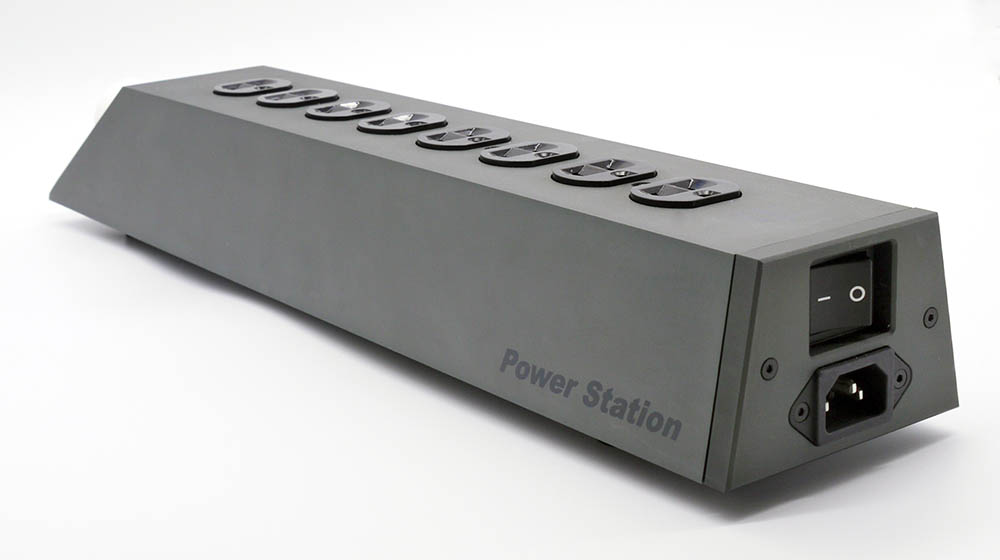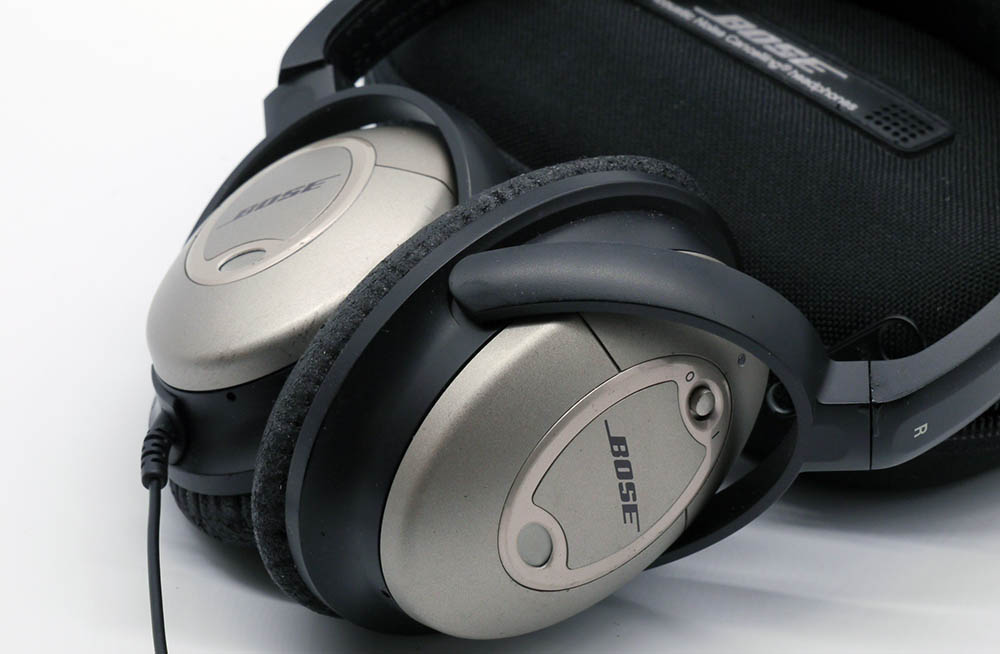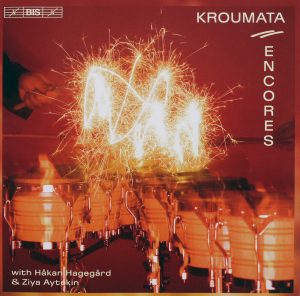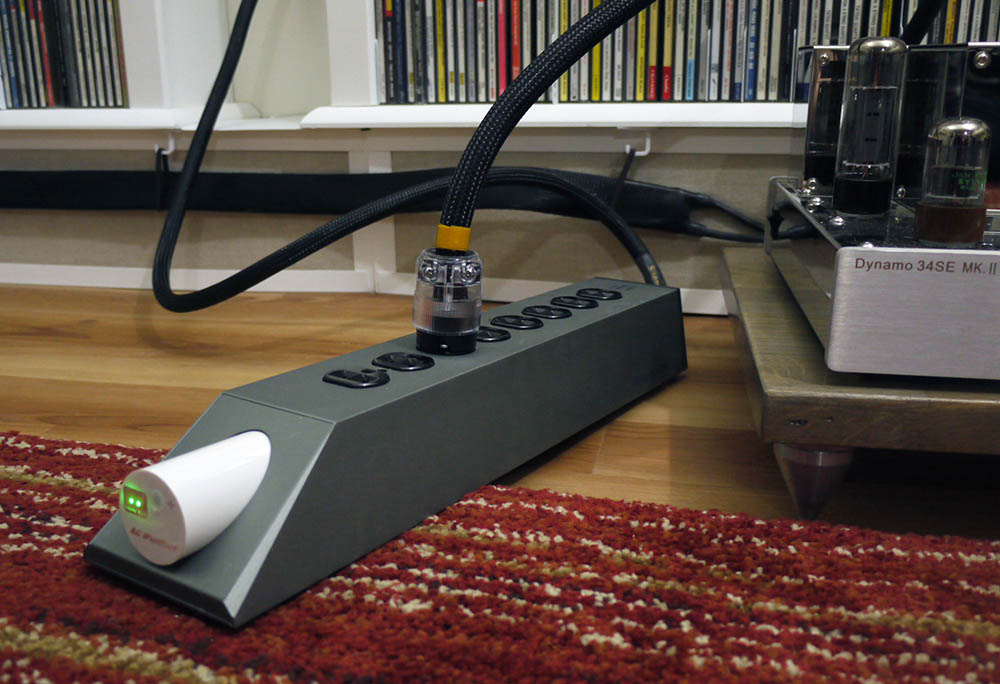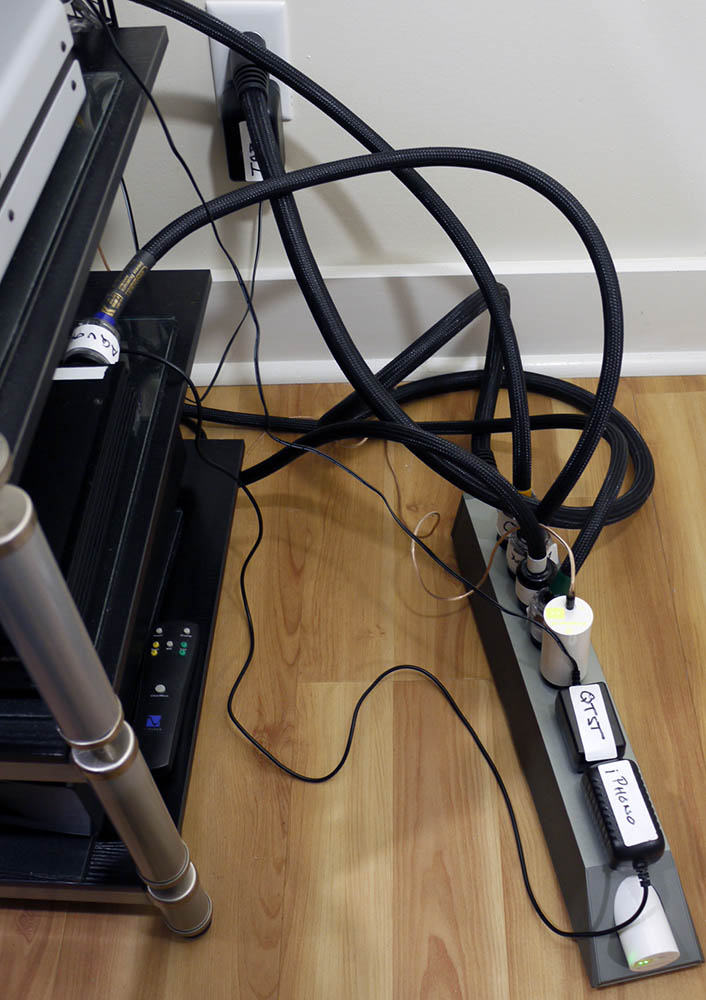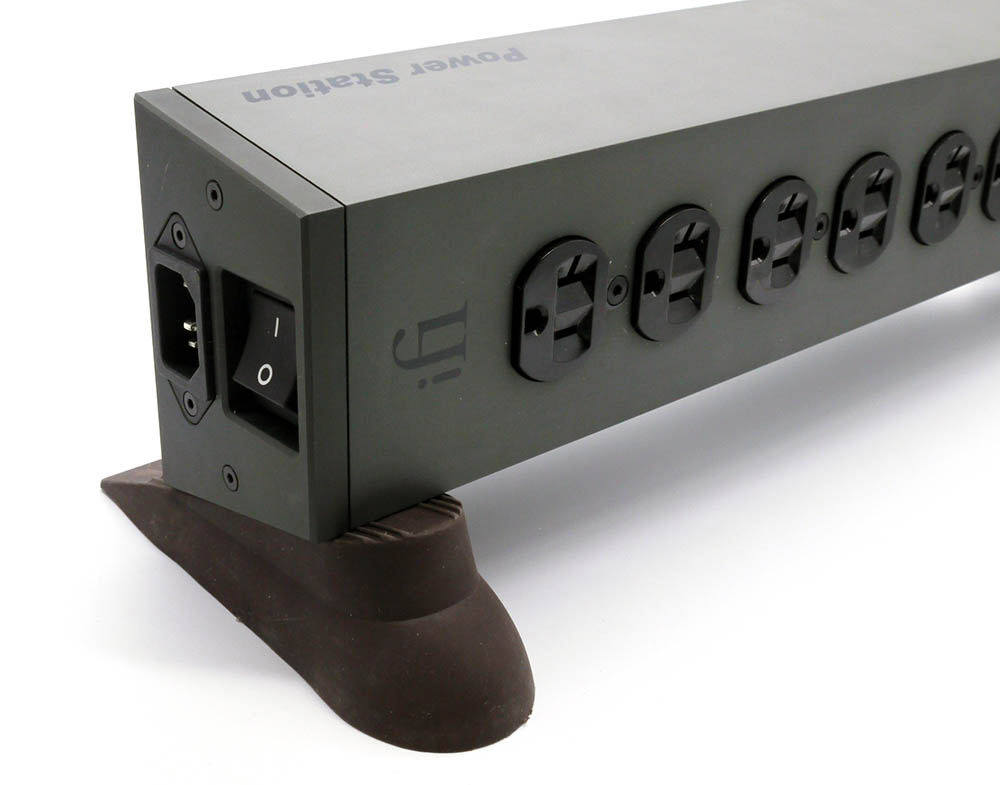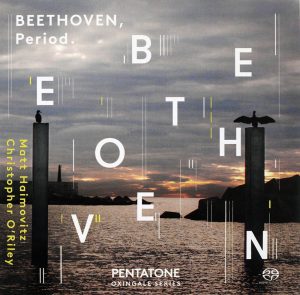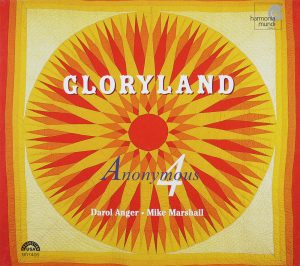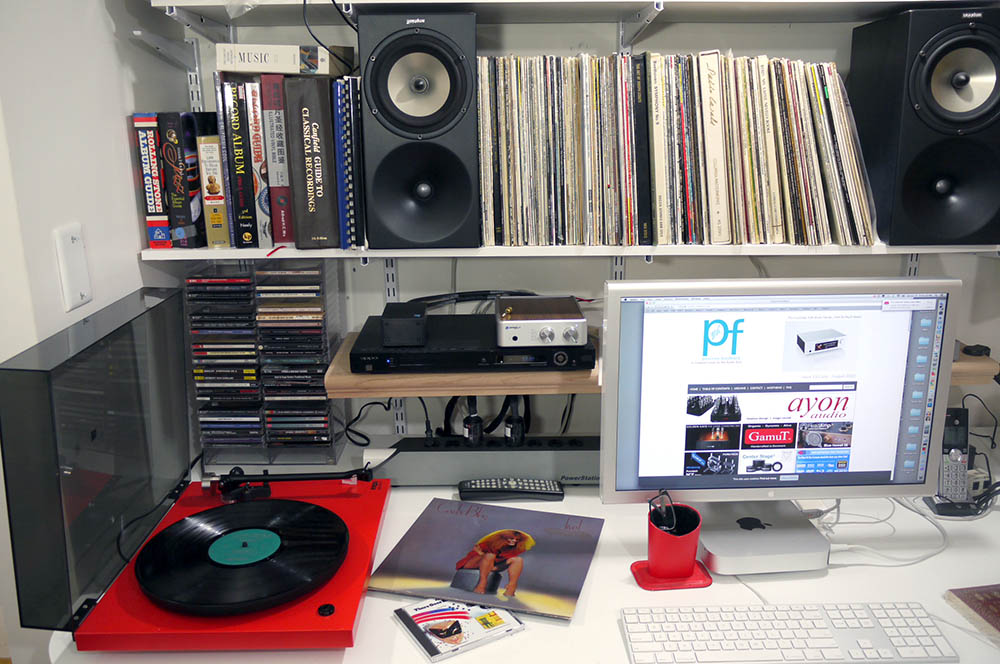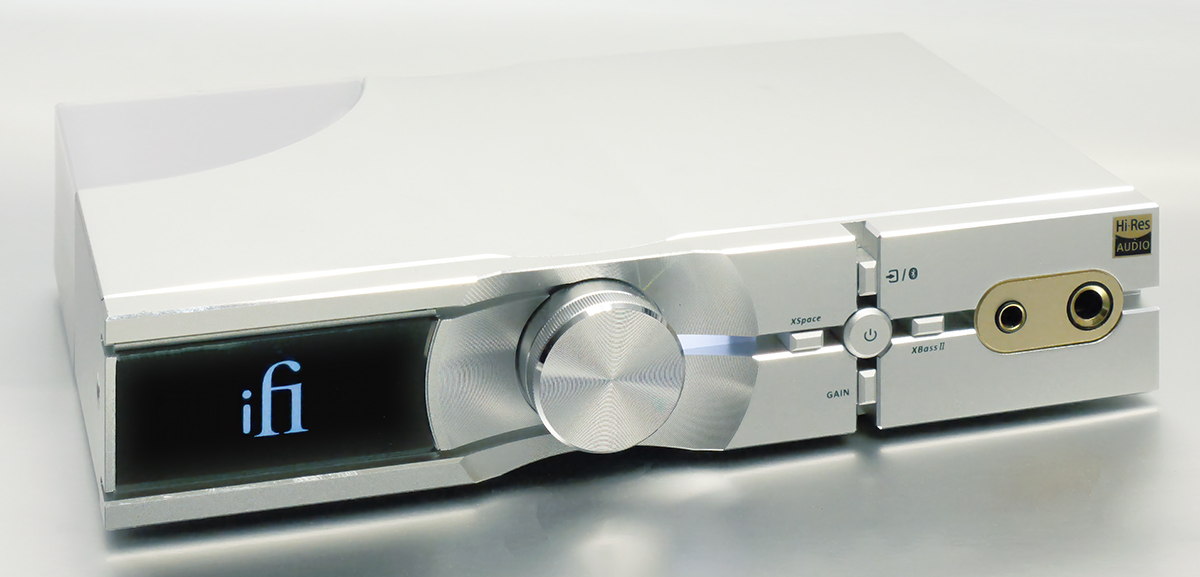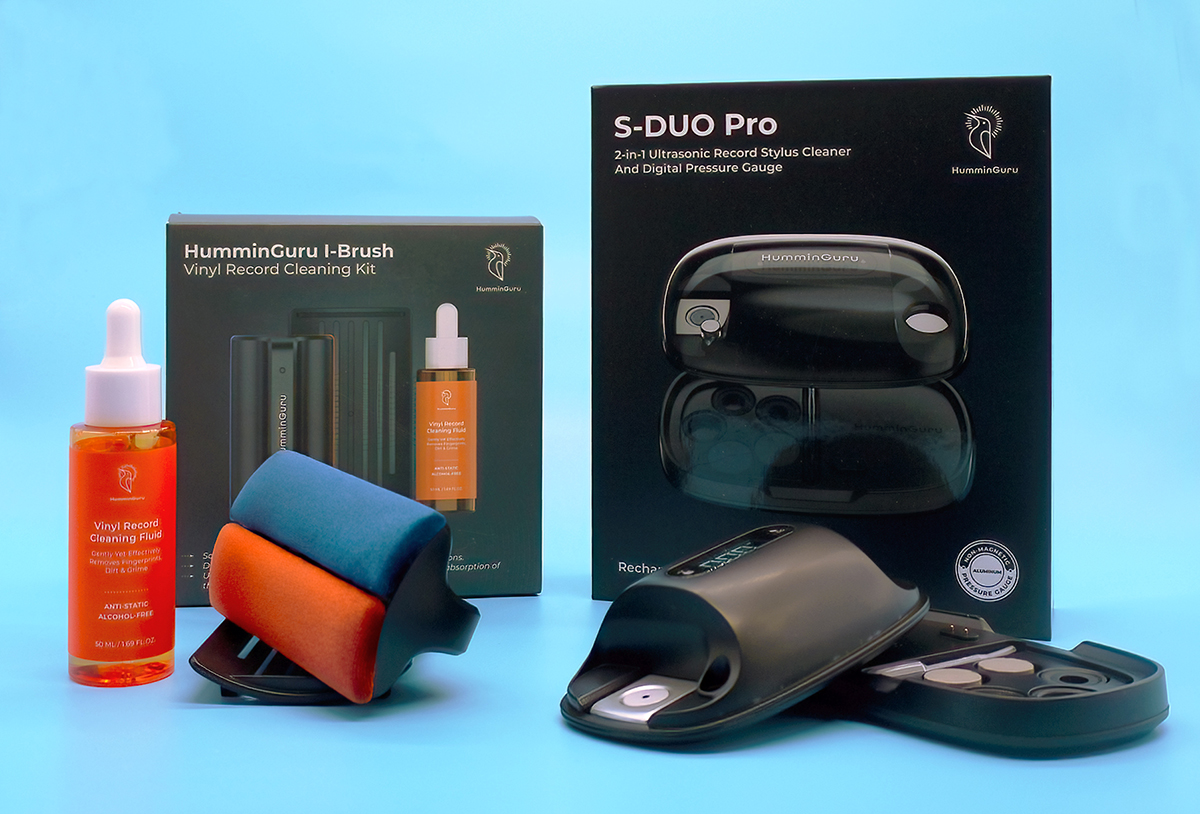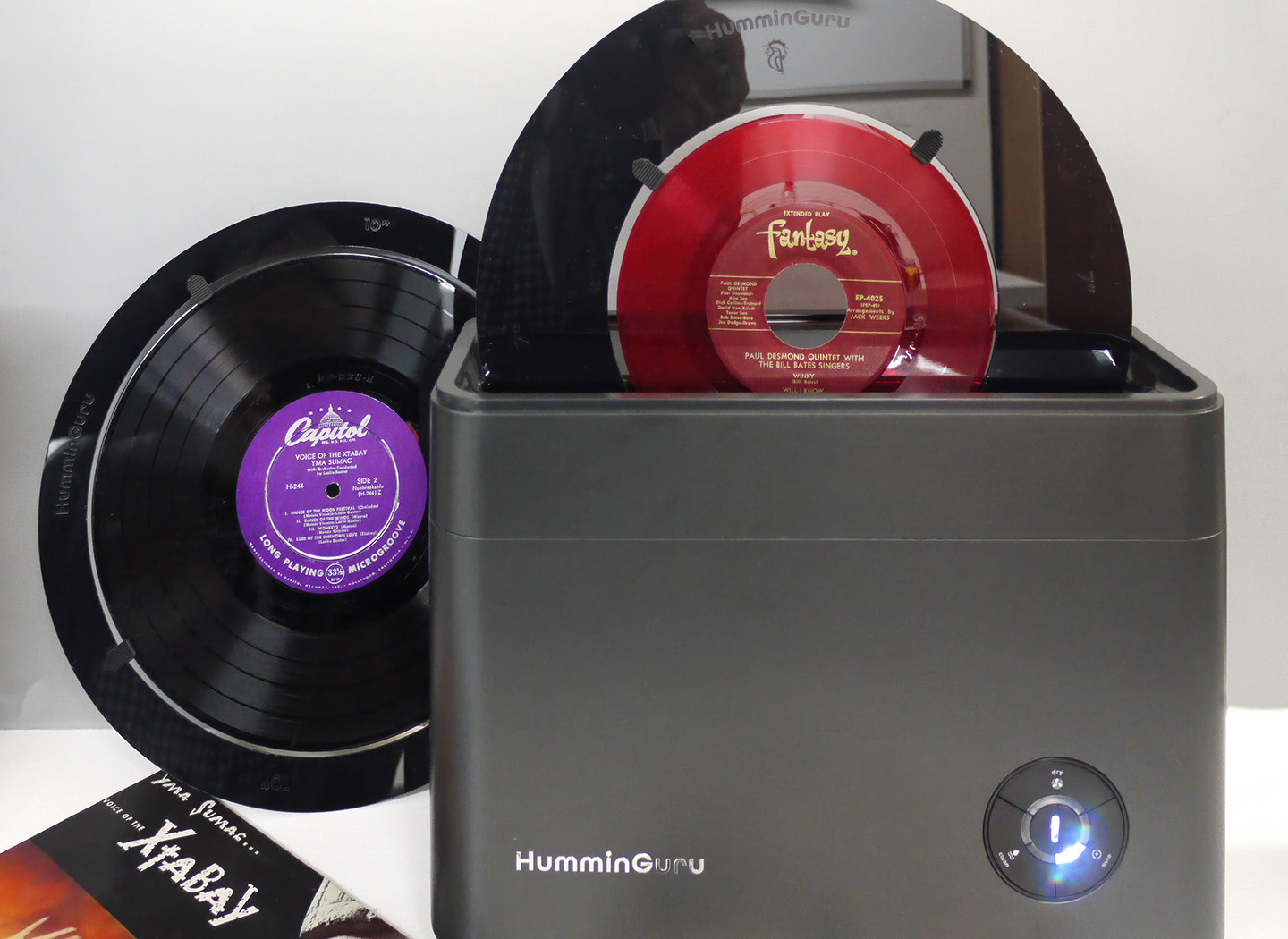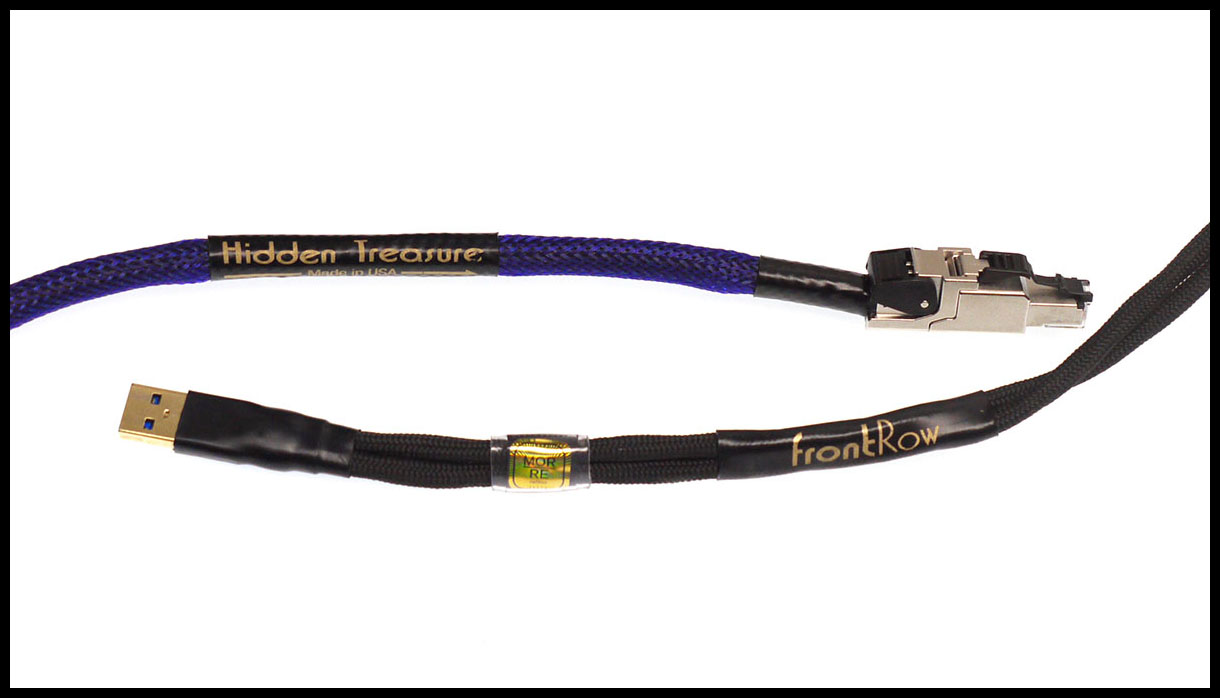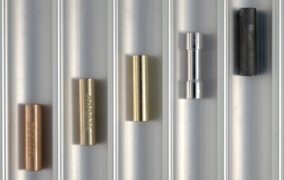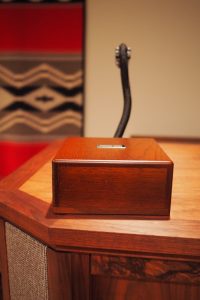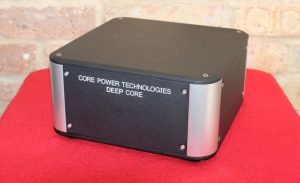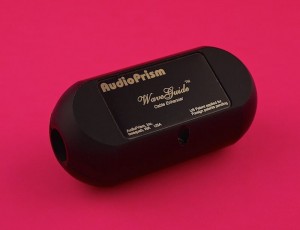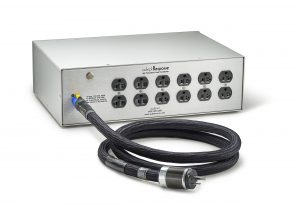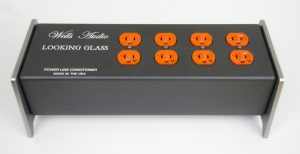Go back some 50 years, and the American audio scene involved an assortment of acronyms from around New England: off the top of my head, AR, ADS, APT, CSW, DBX, EAW, EPI, KLH, and NEAR come to mind, with the BAS (Boston Audio Society) and MIT providing cross-pollination. Oh, and there was one nasty four letter word.
BOSE
Most "serious" audiophiles disparaged Bose, and especially their flagship Model 901 loudspeaker, a vaguely pentagonal box with 8 small, actively EQ'ed drivers on the back, and just one facing the listener. The weird direct / reflected balance resulted in a diffuse sound field and lousy imaging. If I remember the 901 more fondly than most, it's probably because I had a girlfriend who had a pair hung from chains over her waterbed.
Bose was rehabilitated by a very different product: the active noise-cancelling headphone.
The trick was ingenious: a microphone on the outside of the headphone picked up the ambient noise. The electronics inside inverted the electrical phase of the noise, and injected it into the earpieces, thus cancelling out much of the noise. Wildly expense for a headphone by the standards of the time, but half the suits in 1st class always seemed to have them. This pair I got at a thrift store last year for $6. Patents expire, there are plenty of noise-cancelling headphones now—and it turns out active noise cancellation is not just for headphones any more. If you want to cloak a stealth fighter jet or hide a submarine, it's just the thing.
Meanwhile, back in Olde England, another clump of acronyms (QUAD, SME, KEF, NAD, etc.) were the backbone of the UK audio industry. AMR (Abbingdon Music Research) is a more recent and less familiar 'nym, but iFi, their budget line, has become a major player in the areas of high-value DACs and accessories. (iFi of course is not a proper acronym; it's just "HiFi" in Cockney.) iFi has been "quietly" entering the power segment of the industry for several years, first with a set noise cancelling switch-mode iPower supplies for 5v, 7v, 9v, and 12v equipment. I use one with my iPhono.
iFi's next significant power product was the cylindrical AC iPurifier ($99, reviewed by Tom Gibbs HERE), which applied active noise cancellation to AC power line noise. Plug it into a duplex socket, and the second outlet is thus conditioned. I've had one for a couple years, using it mostly on my desktop system. iFi had even suggested plugging it into a power strip to condition more outlets…so it was perhaps inevitable that the iFi PowerStation would materialize, if unexpectedly melding an AC iPurifier to what looks like a surplus F-117a Stealth Fighter cockpit power strip. At roughly 19"L x 4"W x 3"H it's bigger than it looks in pictures (and too long to fit in my video system cabinet). The 4.4 lb weight and no-nonsense industrial design emphasizes that this is a serious device intended to compete with imposing audiophile power conditioners retailing for many times its asking price of $499 USD. One clue to this ambition is the thoughtful inclusion of indentations in the base plate for third-party footers (points up).
And it sure looked like the perfect upgrade for my desktop system (Rega Planar 3/Zu Denon 103, OPPO DVD/CD player, PS Audio Sprout 100, and Amphion Argon 2 speakers) that has been sharing a surge protection strip with a Mac Mini, display, printer and scanner. I contacted iFi, and they kindly sent me a PowerStation. Some serious but non-Covid medical issues delayed this review, but the pandemic also allowed for a more in-depth evaluation, so I decided to put it to the test first with my main system. While my set-up pales compared to some other reviewers' high end rigs, I think the only things in it costing less than $499 are the platter mat and the HDMI and Toslink cables used by the D.BOB.
Power conditioners have been a growth sector in high-end audio for a while. The competition has primarily been between noise filtering systems (Audioquest, Audience, Shunyata, et al), AC regenerators (PS Audio primarily), and what one might call alt-fi non-invasive noise reduction (Synergistic Research, High Fidelity Cables, etc). While it is "easy" to spend $10K on a top-line AC conditioner, the only sub-$1K products from the usual suspects are basically power strips with upgraded outlets, and minimal if any "conditioning." The iFi approach adapts military-style noise-cancelling circuitry for mid-frequency RFI (10kHz to 100mHz) combined with more traditional passive filtration for high frequency RFI (over 100mHz). In an industry where most "secret sauces" are closely held, iFi provides considerable documentation HERE.
To summarize, there's incoming AC line noise (which can include noise from all the neighborhood's household appliances, LED lights, dimmers, computers, air-conditioners, etc., as well as your own), plus radio, TV, cell phone and wi-fi airborne signals. And a modern HiFi system generates its own noise too, particularly from switch-mode power supplies, and digital circuitry. (iFi does make mention of their own low-noise switch mode supplies, of course). Scroll further down the link and you'll see iFi's own graphs of the PowerStation's effectiveness, but grain of salt here. Every audio installation is unique, every power delivery situation is different, and every component interfaces with RFI noise in a particular way. What matters is how a given power conditioner—like any other component—affects the sound, for better or worse, in a given system.
And here I must cop a plea. I live on the island of Martha's Vineyard; our power arrives via undersea cable and we are otherwise not connected to the grid. There is no industrial activity, we are beyond the reach of broadcast TV, and only pick up a couple FM stations. Cell phone service sucks. Eight months of the year, the total population is around 17K, and the AC power quality is quite good. This computer sees only two wi-fi signals other than my own. Small town living, beaches empty of Yankees fans. Then, come a typical summer, we are visited by 100,000+ beach lovers with their cell phones, flat screens, computers, wi-fi, air conditioners, and hair dryers; the AC quality drops and noise goes up. But, in case you haven't noticed, this is not a typical summer: we have but a fraction of the usual hordes, and the power situation remains salubrious-unfortunately not an ideal scenario for testing a power conditioner.
And evaluating power conditioners is like a double-edged sword. If the incoming AC has a lot of noise, one should expect to hear an improvement with a conditioner. But if the AC is clean, and if one's system can reveal differences between power cords, audiophile outlets, cable and connector metallurgy etc., you may find adding a second power cord (with two more connectors) and any conditioner degrades the sound slightly due to "insertion loss." Even low-power amps can demand serious current, instantaneously. Excepting the few expensive conditioners which feature "power correction," most are essentially subtractive filters. RFI "noise" itself is usually far above audibility, but the "works," capacitors, inductors, wiring, outlets, proprietary circuitry, etc., that the current must pass through can affect audible frequencies and dynamics as well. That is why lots of power conditioners actually feature "high current," less or non-filtered outlets for power amps. Like many audiophiles, I have often preferred running amplifiers straight in to the wall, and especially now that my present configuration involves a 6m run of interconnects from the equipment rack to amp. So starting at the power amp end made sense. I gave the PowerStation about 125 hrs of run-in before sitting down to listen.
The PowerStation ships with a generic plastic 16 gauge AC cord that many will just discard if they have invested in upgrade cables, but I gave it a try—I found a similar generic in my closet. I also used two approximately 10 gauge Coincident ST-10 Statement power cords ($595 USD). Yes, I know that each cost more than the PowerStation itself, but they are excellent (although not widely known outside of Canada) and well broken in. I first bought one for my Coincident Dynamo amp, then a few more over time as they proved superior to what they replaced, and Coincident's Israel Blume provided 3, 4, and 5-foot lengths to greatly minimize cable snarl behind the rack.
One recording I find useful for evaluating components is Kroumata Encores (BIS SACD), especially Anders Loguin's "Untitled" (Twelve cymbals in a striking encounter). It is a subtle percussion piece that features the complex shimmer, color, and decay of cymbals in an expansive space. Even the exquisite 10 wpc Valvet 2se dual mono, single-ended Class A solid state amplifier ($3990 USD, review HERE), sounded flat and boring with the PowerStation and generic AC cords. Using the Coincident cords with the PowerStation, almost all of the magic came back, but the bypass test revealed a subtle diminution of high frequency dynamics, air, and clarity. The soundstage was as wide, but somewhat shallower through the PowerStation than running straight into the Furutech GTX outlet, and the different cymbals were less well differentiated spatially and tonally—but actually, the iFi held up well compared to several more expensive conditioners embarrassed by this test. Conclusion: use the best power cords you can with the PowerStation. But hey, was the subtle loss due to the PowerStation circuitry, or just the step-down from a $250 audiophile outlet to the good but less exotic ones iFi sources at a price? Somewhere, someone with a screwdriver and a soldering iron will be willing to void the warranty to find out-but not me.
My "cold basement in winter" amp is still the over-achieving Coincident Dynamo 34SE MkII (now in MK III iteration, but around $1600 when new). The Dynamo also turned out to be a fine match for the PowerStation—the insertion loss issue was of much less consequence. This 8 wpc tube amp is flat-out fun, especially on non-classical fare where the EL34 midrange "bloom" enhances both vocals and instruments. For example, I spent an evening with the 2003 Columbia SACDs of Dylan's Blond on Blond. The Dynamo-PowerStation package conveyed the rowdy and raucous studio atmosphere I remembered the from the LPs back when I inhaled; with the Valvet and PowerStation, even Greg Calibi's SACD re-mastering couldn't disguise the rather unvarnished recording. Conclusion: the PowerStation conveys the emotional / cerebral characteristics of the equipment plugged into it.
But could iFi ever forgive me for preferring the sound of my power amps plugged straight into a clean dedicated circuit via a fancy outlet? To find out, I unplugged the PowerStation and took it over to the source equipment rack some 12' away. There I had access to the other dedicated 20A line, as well a pre-renovation 15A household circuit, which I knew fed dimmer-controlled LED lights as well as other suspect problem loads. A 12 yr-old PS Audio Power Plant Premiere ($2195 when new-but up to $900 on eBay last week) feeds 120V to the OPPO 205 disc player, the D.BOB SACD liberator, the AQVOX current mode phono stage, and a BSG QØL processor; the Nottingham Spacedeck / speed control, the iFi iPhono, and the Chord Qutest DAC employ the dreaded switch-mode power supplies. The Bent Audio TAP passive transformer based preamp uses a 12V wall-wart for the display and switching relays only. That's 8 outlets, the max on the PowerStation (the PS Audio has 10).
My penance was clearly to shut every thing down, Deoxit the connectors, and plug everything back in to the PowerStation. Piece of cake, right? Not quite. Part of the long sleek look of the PowerStation is due to the linear (as opposed to side by side) layout of the duplex outlets. Problem is, a lot of switch-mode and wall-wart plugs are oblong, not round; the ultra low noise power supply for the iPhono a case in point: unless at an end of the row, it blocks two outlets—and so does the Qutest plug. Plus, one of the neat things about the PowerStation is that one can insert an AC iPurifier in a middle outlet to separate switch-mode from standard plugs, or digital from analog. Decisions had to be made. The bulky TAP wall-wart and the Spacedeck speed controller plugs were consigned to unfiltered AC outlets.
The layout I ended up with is as shown, from front to back: iPhono, Qutest, AC iPurifier, D.BOB, OPPO 205, AQVOX phono, and BSG QØL (though not used in reviews, it subjectively doubles the size of my small listening space when I just kick back). Ergo, 6 components and the AC iPurifier, grouping analog and digital pairs as each duplex is isolated from the other. If you look closely, you will also see the Spacedeck's static-killing chassis ground wire happily plugged into my AC iPurifier's clever grounding socket. To keep a level playing field, I powered the PowerStation with the same PS Audio xStreme Statement Power cord (6-8 gauge, $600 as I recall) I've always used with the PS Audio Power Plant; the Valvet amp was, yes, plugged straight into the wall.
From an ergonomics point of view, the PowerStation is designed to be placed horizontally, outlets up, which works fine on the floor. But, like the majority of audiophile power cords, the Coincident and PS Audio cords are thick, stiff, and resistant to bending-and so it's impossible to install the PowerStation as intended between the shelves of a typical audio rack. Most of the heavyweight high-end conditioners, like the PS Audio Premier, have the outlets on the rear; the iFi's trapezoidal cross section makes that orientation awkward at best. The fix is stupid-simple: a couple of ordinary doorstops and some Velcro do the trick:
For several evenings I rotated through each conditioner working with a 20A dedicated line and audiophile outlet as well as with a generic $1.59 outlet on the noisy 15A household circuit. As a control, I also plugged the OPPO, D.BOB, and Qutest into the generic computer surge strip I use with my desktop rig via the 15A outlet. I used a variety of familiar CDs, and SACDs. I live alone, so no way double blind, but the results were clear.
Win: PowerStation/20A. Off the dedicated 20A line, the iFi definitely provided the best resolution, image specificity, and dynamics. It was subjectively the "cleanest," and nicely conveyed the U.K.'s beloved PRaT, and so easily preferred on jazz and rock. There was a slight upper-mid emphasis but no added digital glare. Excellent on strings and vocals, conveying complex harmonics and inflection. Loves the violin. Noise floor was subjectively lower than with the PS Audio, and overall presentation was more vivid. Music has "Bounce."
Place: PS Audio/20A. With the 20A line, the Premier sounded more spacious than the PowerStation, particularly in terms of depth, although in contrast to the iFi, it also seemed slightly slower, if tonally richer / warmer. It was not as adept at initial transients or rhythmic accents, but provided somewhat better sustain and decay. It seemed to convey a mild lower mid-range emphasis and rolled off highs compared to the iFi. Particularly lush and powerful on orchestral classical, organ, etc. Loves the cello. Vocals lacked some harmonic complexity. Music has "Flow."
Show: Tie, as neither conditioner was at its best off the known "dirty" line and $1.59 outlet; the positive characteristics noted above remained, but the negative aspects were more apparent. The PowerStation thus sounded somewhat "flatter," the PS Audio "slower," etc. However, such results are probably more representative of mainstream installations; but fear not, Lowe's and Home Depot stock hospital grade outlets for far less than $250. Conclusion: a power conditioner cannot replace what has already been lost.
Out of the running: the computer strip and 15A circuit. Of course, this is why I wanted to try the PowerStation in the desktop system to begin with.
Interestingly, the PowerStation feeding the source components excelled at the very characteristics—high frequency resolution and dynamics—that I found problematic with it feeding the power amps. That is not a contradiction; it's a reminder that a power amp places quite different demands on a conditioner than do source components. When audiophiles speak of "lowering the noise floor," it's often not about the no-music, barely audible hiss from the loudspeaker. The oxymoron here is that inaudible RFI can interact with electronics processing audible-range signals, and thus become audible as a blurring of subtle textural, spatial, and temporal information. Permit me to compare apples to oranges: power conditioning is like removing peach fuzz to create a nectarine.
Different power conditioning technologies should sound different, just as tubes and solid-state amps sound different. One recording nicely embodied the tonal differences between the two units: Matt Heimovitz and Christopher O'Reilly's recording Beethoven, Period, featuring LVB's Cello Sonatas, on Pentatone SACD. Heimovitz relates that on "modern" instruments a cellist has to struggle to balance the power of a Steinway. Here, O'Reilly plays an original 1825 Broadwood fortepiano, most unSteinway-like in tone and dynamic range, and easily overpowered by a modern cello. Heimovitz thus plays his 1710 Goffriller retrofitted with really old-school gut strings, and a 19th century tailpiece and bow. The PS Audio emphasized the sonority of the cello; the PowerStation, every nuance of the fortepiano. Like two very different performances!
OK, but I could still live with either…until on impulse I swapped out the PS Audio power cord for one of the Coincident ST-10s as the PowerStation input. Gadzooks, the proverbial veil was torn asunder, and the iFi bargain with a full Coincident power loom lapped the field. I was treated to some of the most enjoyable sound I've heard from my system. The increased definition and subtle dynamics of the fortepiano were balanced in the 3-D soundstage by the bloat-free power and articulation in the cello's lower register. Everything was clearer and way more "real" i.e., the noise floor dropped. I tried the Premier with the Coincident cord, but only it improved the relaxed, spacious presentation of the regenerating unit to small degree. Conclusion: the power cords really matter with the PowerStation.
And so it went, disc after disc. One of my favorite female-vocal test recordings is Gloryland, the Anonymous Four's second Americana outing, featuring epic multi-instrumentalists Darol Anger and Mike Marshall. Distinguishing four skillfully blended voices in the soundstage by location and timbre along with the instruments amid the reverberant characteristics of Skywalker Sound is a challenge the PowerStation let the system pull off with aplomb. You don't have to be a fan of early folk music, shape-note hymns, or gospel / revival songs to appreciate this recording, and it seems particularly soothing in these difficult times
Next, and with rather mixed feelings, I finally unplugged and transferred the PowerStation to the desktop system. It slid in underneath the Sprout 100 and the OPPO 980H shelf, and behind the Rega, but space is tight, no way the stiff Coincident cords could turn the corners, so I used some super-flexible Tel-Wire cords (no longer available) they had replaced. This allowed me to organize all the audio gear to the left of the monitor, and the printer, scanner, disk drive etc. in a surge strip to a different outlet on the right. Powering up, the improvement over the previous power strip was obvious, top to bottom, sounding much closer to my "big rig." I use the desktop set-up primarily to audition LPs after cleaning them on my VPI-HW 27, to stream NPR and music when I'm at the computer, and to play CDs in the background while I'm working on other projects. Unfortunately, the PowerStation-improved sound will surely and adversely affect my productivity, as I keep pausing to just sit back and listen. At least I can now really enjoy using my noise-cancelling (not by Bose) headphones while running the HW-27.
With the introduction of the PowerStation, the clever folks at iFi have stuffed some remarkable power conditioner technology into an attractive device at an even more attractive price. While it will work perfectly well with modest electronics and regular household AC outlets, its performance really scales with upgraded power cords, outlets, and high-end active components. You might want to try one before dipping into the little brat's college fund to spend a lot more. Conversely, without experiencing power conditioning of this quality, one may never hear what the rest of one's system is capable of. Welcome to the audiophile life.
Highly recommended!
iFi PowerStation AC Power Conditioner
Retail $499 USD




